There are many excellent collections of records and documents on Ancestry, but you can only find what you are looking for if you know how to use the search feature. In this post, find out the best tips and tricks for doing a search on Ancestry.
There are more than 6 billion records on the Ancestry site, according to the official company website. Chances are good that there are many records pertaining to your ancestor.
The question is: how to find them?
I've been using Ancestry for many years, and I have learned the tips that I share in this post through lots of practice searching. I hope that these tips help you find those records you are looking for.
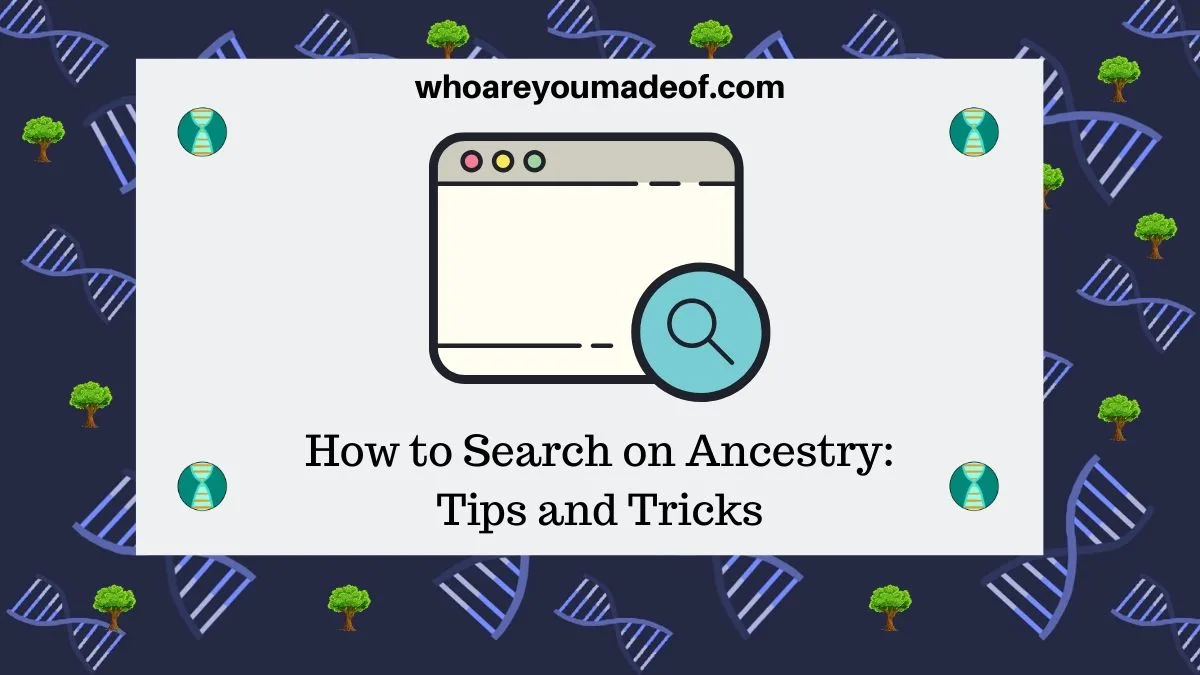
Tips for Searching on Ancestry
I've included ten tips in this post to help you get the best results for searching on Ancestry. You will maximize the chance of finding the information that you are looking for.
Start with the hints on your Ancestry tree
One of the first things that you can do when researching your ancestors is to check out the hints that Ancestry has provided for you on your family tree. These hints have been automatically selected by Ancestry's powerful algorithm as having a high probability of matching your ancestor.
The best place to find your tree hints is on your ancestor's profile page on your Ancestry tree. You will see hints on the tabs of the profile after Facts and Gallery:

In the image above, we can see that this particular person has 32 tree hints. If I click on the tab, I will see a list of hints.
Each hint has a connected record or document, which I can then examine carefully. If I decide that the hint is connected to my ancestor, I can add the information automatically to my Ancestry tree.
The hints aren't always relevant to your ancestor, but they are certainly work checking out. Sometimes, our tree hints can provide clues that help us in future searches.
Try adjusting the sliding search filters
When you are using the main Ancestry search, it's important to know that you can use the sliders at the top left to adjust how exact you want the search function to match the terms that you entered.
This is an easy to way to search for names that sound like or are similar to the names that you entered. Sometimes, records are transcribed incorrect or spelling errors occurred on the original record.
Maybe your ancestor is referred to by an abbreviated version of their name, or even a nickname,
In the image below, you will notice that the red arrow is pointing to a green dot next to the name "Mary". Right now, it's on the broadest setting, which means that I might get results for "Merry", "Marie", or "Maria", or any other first name that is similar to Mary.
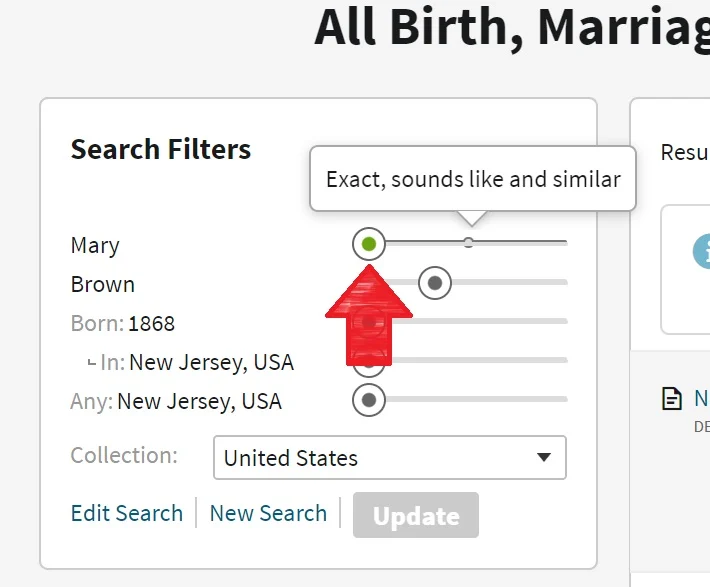
If I am searching for a super common name (such as Mary), which is not likely commonly misspelled, I might slide the search feature to the right to make the search result more specific. You should then only see results that match "Mary" exactly.
You can play around with this feature on many of the search fields that you designated. For example, if you aren't sure exactly how the last name is spelled, you can leave the search slider on the broadest setting.
If you receive too many results, making the slider more specific is a good way to reduce the number of records that you need to sort through.
Search with alternate spellings
I was born with the last name of Brons. This name was commonly misspelled and mispronounced. Sometimes, people called me "Brown" or spelled my last name as Bronze.
When I am searching for records about my ancestors, I will often try alternate spellings of the surname. In the case of Brons, I might try "Bronze", "Bronse", "Brown", or even "Bron".
First names and last names are both likely candidates for misspellings, especially if the person who has the name and the person who did the writing down of the name on the record spoke different first languages.
Additionally, most old records need to be digitized and transcribed by a human in order to make a searchable index and make the record available online. This is further opportunity for the name to be misspelled once again.
Be as specific as possible in your search
When it comes to searching for records on Ancestry about your ancestor, the more you know, the better chance of getting good, relevant search results.
For example, if I am searching for Mary Brown, which happens to be an exceptionally common first and last name, I will have better luck finding records about my Mary Brown if I know approximately when and where she was born.
Any little detail can help narrow down the search.
The same is true even for records about your ancestors who have less common names. You might be surprised how many people with the same first and last name lived in Newark in 1890, so entering the approximate place and/or year of birth can help you get better results.
Try searching with less specific information
It can sometimes be helpful to take out a search term in order to get less specific results.
For example, maybe my ancestor, Mary Brown, was married to a Robert Miller and I know that they lived in New Jersey because they are living in Newark in the 1880 Federal Census. Perhaps they are both recorded as having been born in New Jersey on that census.
It's possible that Mary Brown wasn't really born in New Jersey. Maybe the census taker wrote down the wrong state, or a neighbor or other family member provided incorrect information.
Perhaps I could remove the state of birth, leaving all other information in the search. Alternatively, I could use the sliders to allow the search results to show people who were born in adjacent states.
Narrow your search by type of record (category)
One of my favorite search tips is to only search a particular category of records. I often find myself looking only for one type of record, so it makes the most sense to filter search results to only show records that fit with what I am looking for.
When you are searching on Ancestry, you can choose the category of results that you would prefer to view on the left side of the screen under the "Filter by" heading.
In the image below, the red arrow points to the Birth, Marriage, and Death records category. These types of records are often referred to as "vital records".
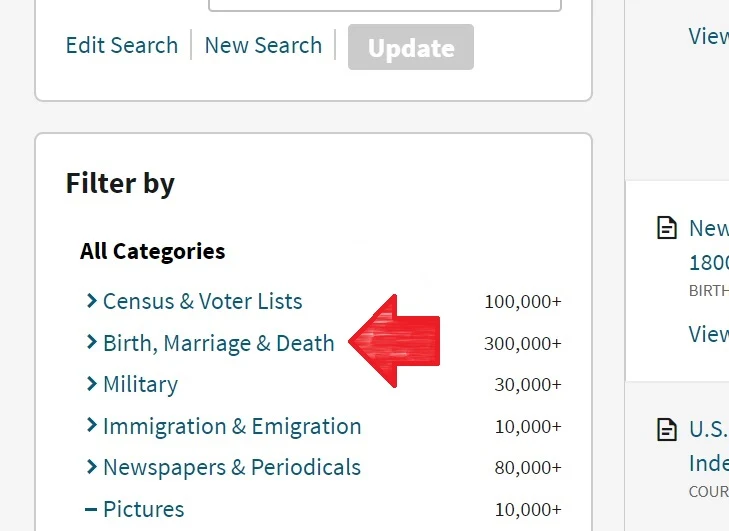
You can see from the image above that there are more than 300,000 records pertaining to birth, marriage, and death of people who are named Mary Brown.
That's quite a high number of records, but fortunately I can further narrow down the search to include only a specific type of vital record. For example, I can see that there are 30,000 birth records that match my search parameters:
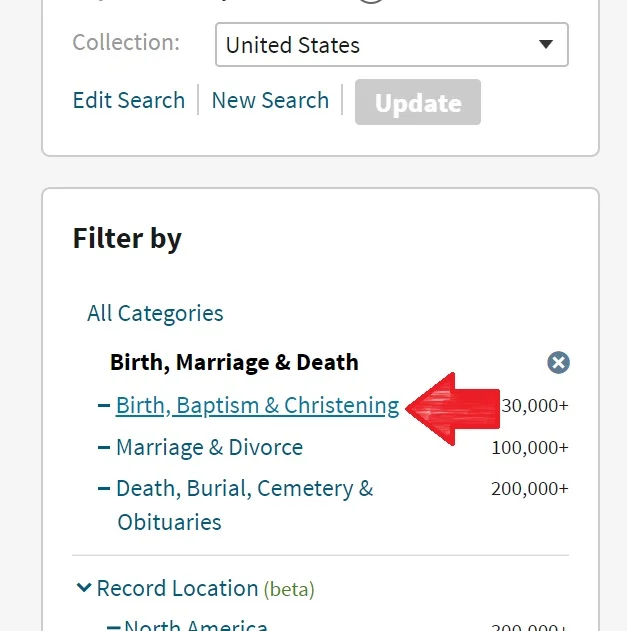
If I click on the Birth, Baptism & Christening category, I can further narrow my search by using the slider or by adding another search term in the search box.
Use wildcards in your Ancestry search
A few years back, I visited the New Jersey State archives. I was looking for my great-grandfather's birth certificate and couldn't find it.
As it turns out, there is yet another opportunity for mistakes in transcribing and creating indexes.
When I mentioned my struggle to the helpful man at the information desk, he suggested that my ancestor's name may have been indexed incorrectly.
The indexes that we find in archives were created by individuals. These indexes help people looking for the individual record know which book or collection it is in.
My great-grandfather was Polish, and there is a good chance that the person who looked at his birth certificate misinterpreted his first name. The man at the archives suggested looking for similar spellings of his name beginning with a different letter.
As it turns out, some letters look a lot like others when trying to read cursive handwriting. I don't blame the indexers - I've dabbled in indexing myself and it can be really hard to read handwriting.
Fortunately for us, we can use the power of a computer to search on Ancestry using a special character to tell the software that we would like to see all of the search results that are spelled with any letter as a substitute for our special character.
This special character is called a "wildcard". How it works is you use the wildcard character for the letter that you aren't sure about.
For example, if I am looking for information about a man named Smith Dixon who lived in Illinois, I might put the wildcard symbol at the beginning of his name. Maybe his name was confused with Nixon and indexed incorrectly - who knows?
To do this search, I will put an asterisk instead of the first letter of his name. You can also use a question mark.
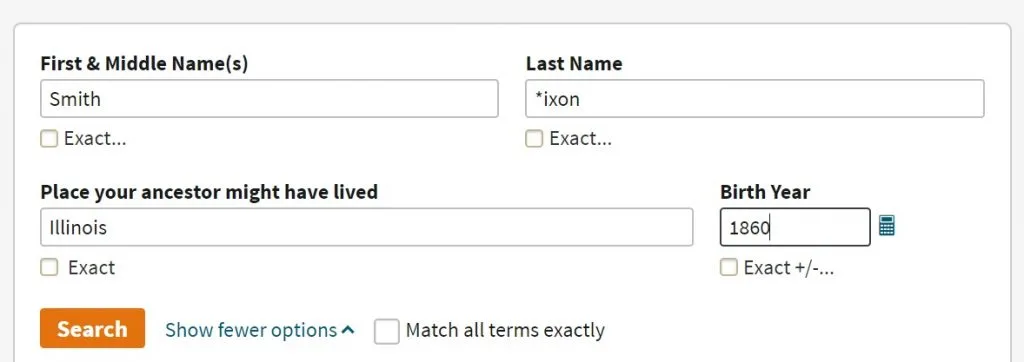
My search results will include all of the people named Smith with the last name Dixon and Nixon (and other names I haven't even though of, likely) who lived in Illinois born around 1860.
Use your female ancestor's maiden name and married name in separate searches
Ah, researching our female ancestors. It presents unique challenges.
One of those challenges is the changing of the surname. Most women in the United States take their husband's name when they marry.
The name the were born with, their maiden name, may or may not be used on records. This means that you should always do a clean search using your female ancestor's married name and their maiden name.
You can also try using them both together, with the married name as a middle name. If your female ancestor had more than one marriage, you can try searching using their other husband's surname, too.
Try using the keyword field in the search
If you know a detail about your ancestor that doesn't fit into any of the other search fields, you can try using the keyword search. This detail could be something like their occupation, or the name of the street that you know that they lived on.
For example, if you know that your great-great uncle was a musician, you could try putting this into the keyword field in order to get results for people with his name who may have reported "Musician" as their occupation at some point in their lives.
Conclusion
I hope that this post has helped you learn the best ways to utilize the Ancestry search feature. There is so much that you can learn about your family tree by searching the billions of records available in Ancestry's collections.
If you have any questions about something that you read in this post, or if you would like to share your own tips for searching for your ancestors on Ancestry.com, please join us in the discussion below.
Thanks for stopping by today!
